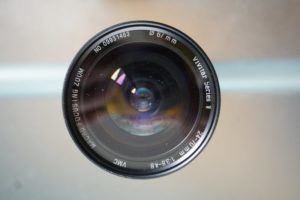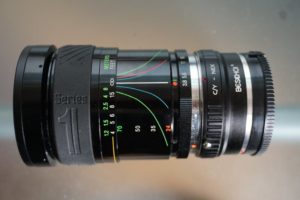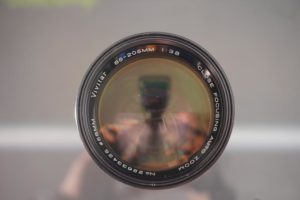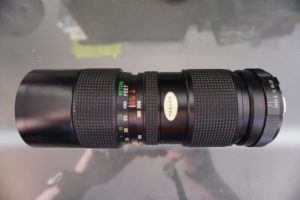In my view, some vintage zoom lenses are highly underestimated. You can get a vintage zoom lens for a good bargain if you don’t need the speed of vintage prime lenses. Or, you can combine a fast portrait prime lens with one or two vintage zoom lenses to cover the most frequently needed focal lengths with a minimum of cost. At photographic equipment flea markets, offers such as “buy a vintage prime lens and get a zoom for free” are not unheard of.
Jump directly to the focal length and lens of interest:
Vivitar Series1 24-70mm f3.8-4.8
Why using vintage zoom lenses on modern camera bodies?
Compared to modern zoom lenses, vintage zoom lenses can be cheap as dirt. By using those vintage zoom lenses with an adapter on modern mirrorless camera bodies like the Sony alpha 6000 family with APS-C sensor or the full frame Sony alpha 7 family, you can enjoy many high tech features of those top-notch cameras with your 30 years or older vintage lenses. The performance might be worse on the Alpha A7R camera family because of its very high sensor resolution, which brings some vintage lenses to their optical limit. You can use this lenses also on Olympus and Panasonic Micro Four Thirds / MFT camera bodies with appropiate adapters.
What is the crop factor when using those vintage lenses with an APS-C or Micro Four Thirds sensor?
The crop factor is used to compare the field of view of cameras having a different sensor size with the same lens.
On APS-C cameras like Sony alpha 6000, 6300 and 6500, you have a crop factor of 1.52, which means that a 50mm full frame lens behaves like a 77mm lens on a full frame camera if used on a camera with APS-C sensor. In the case of using those full frame lenses on Olympus and Panasonic Micro Four Thirds camera bodies, you have a crop factor of 2. Get a good explanation of the crop factor here: https://en.wikipedia.org/wiki/Crop_factor
The filter thread turns when zooming for all listed lenses, so using a polarising filter makes no sense.
Vivitar Series1 24-70mm f3.8-4.8, approx. EUR 85 at ebay (2016)



Specs: push/pull zoom, 450g weight, 89.5mm length, 11 elements in 10 groups, 8 aperture blades, 67mm filter, lens mounts: Canon Minolta Nikon Olympus Pentax Yashica
The pictures of this lens are shot with a Contax/Yashica to Sony e-mount adapter connected to the lens. This zoom lens is quite unique and from the later vintage lens ages, as it starts with the short focal length of 24mm. Therefore this lens gives a usable zoom range on cameras with APS-C sensor like the Sony alpha 6000 family, equivalent to approx. 36.5mm to 106.5mm focal length on full frame cameras. The lens has good sharpness and contrast and low chromatic abberations. A Macro of 1:5 is not a true macro, but a useful close-up option. The lens was built in the late 80s by Cosina as a professional zoom and it’s list price was more than USD 400. The length of the lens changes when zooming.
See some discussions and test photos about this lens here: https://www.pentaxforums.com
Check the image quality of this lens in the 50mm vintage lens shootout: https://tech-reviews.swiss-1.ch/50mm-vintage-lens-shootout/
Get more technical information about this lens here: http://allphotolenses.com
This lens was probably made in 1989. See what else was happening in 1989 here: https://en.wikipedia.org/wiki/1989
Minolta MD 28-70mm f3.5-4.8, approx. EUR 65 at ebay (2016)



Specs: rotating zoom ring, 370g weight, 72mm length, 6 aperture blades, 55mm filter
This zoom lens comes close to Minolta prime lenses in image quality at higher aperture values. The lens, which was a kit lens for the X-300, sharpens evenly across the frame from aperture 8 and up. The build quality is more like lightweight plastic without many metal elements. See some discussions and test photos for this lens here: http://forum.mflenses.com
At the focal length of 70mm you can take 1:4 macro scale pictures. The lens looks like it’s made by Cosina. I bought mine for EUR 10 at a flea market for photographic equipment.
Get more technical information about this lens here: http://allphotolenses.com
This lens was probably made in 1988. See what else was happening in 1988 here: https://en.wikipedia.org/wiki/1988
Tokina SD 70-210mm f4-5.6, approx. EUR 25 at ebay (2016)



Specs: push/pull zoom, 436g weight, 87mm length, 6 aperture blades, 52mm filter, lens mounts: Canon Minolta Nikon Olympus Pentax Yashica
Tokina SD lenses minimize chromatic aberrations for sharp and crisp images at all focal lengths and this is one of the first Tokina lenses with super-low dispersion glass, aka “SD”.
Chromatic aberration is the inherent tendency for glass to disperse (separate) a ray of light into the colours of the rainbow. In lenses made of normal optical glass, chromatic aberrations tend to increase at the same rate that the focal length increases. Get more information about low-dispersion glass here: https://en.wikipedia.org
Tokina solved this problem with super-low dispersion (SD) glass. SD lenses from Tokina have a distinctive red stripe around the lens front. At the focal length of 210mm you can take 1:4 macro scale pictures with a minimum distance of 1.1m. The build quality is like a “T-34 tank”, heavy and with a lot of metal. Because of efficient SD glass, it is rather small in length and diameter for the range of focal lengths covered.
See some discussions and test photos about this lens here: https://www.pentaxforums.com
Get more technical information about this lens here: http://allphotolenses.com
Tokina lenses declare their production year in the first two digits of the serial number “9006780”. Therefore, this lens was made in 1990. See what else was happening in 1990 here: https://en.wikipedia.org/wiki/1990
Tokina SZ-X 28-200mm f3.5-5.3, approx. EUR 60 at ebay (2016)



Specs: push/pull zoom, 690g weight, 109mm length, 15 elements in 12 groups, 6 aperture blades, 72mm filter, lens mounts: Canon Minolta Nikon Olympus Pentax Yashica
This lens is very large (it has a 72mm filter thread!), heavy (almost 700g) and has an excellent build quality using lots of metal. This lens is out of the pre-SD glass area. It’s known for its razor sharpness across the full focal length scale at aperture 8 and above. At the focal length of 200mm you can take 1:4 macro scale pictures with a minimum distance of 1.35m.
See some discussions and test photos about this lens here: https://www.pentaxforums.com
Still not convinced? Check out these photos made with this lens: http://forum.mflenses.com
Check the image quality of this lens in the 50mm vintage lens shootout: https://tech-reviews.swiss-1.ch/50mm-vintage-lens-shootout/
Get more technical information about this lens here: http://allphotolenses.com
Tokina lenses declare their production year in the first two digits of the serial number “8709753”. Therefore, this lens was made in 1987. See what else was happening in 1987 here: https://en.wikipedia.org/wiki/1987
Vivitar 85-205mm f3.8, approx. EUR 25 at ebay (2017)



Specs: rotating zoom ring, 907g weight, 188mm length, 13 elements in 9 groups, 6 aperture blades, 58mm filter, lens mounts: M42 Canon Minolta Nikon Olympus
Long and heavy (approx. 900 grams) and build for a period of more than 10 years in large quantities, therefore cheap to get. This lens was produced by Kino Precision Industries in Japan for Vivitar and other brands and is probably one of the cheapest ways to cover 200mm focal length with a lens having an acceptable image quality and a max. aperture better than f4. The appearance of the lens was revised several times to match the currently marketed family of Vivitar lenses.
This zoom lens has a detailed wiki page, explaining many product details and all 10 production versions: http://camera-wiki.org/wiki/Vivitar_85-205mm
Find some review information about this lens here: https://www.pentaxforums.com
See, how damn sharp the inexpensive vintage zoom lens Vivitar 70-210mm f3.8 is at 200mm and f5.6
First picture of the gallery below was taken with 24mm focal length (full frame equivalent) and the second with 75mm, both with the Sony SELP1650 kit lens. The third picture was taken with the Vivitar 70-210mm at 200mm focal length and aperture f5.6. The forth picture is a 100% crop of the clock:
Vivitar, originally founded as Ponder & Best Inc., was established in California in 1938 as a distributor of photographic products by the German immigrants Max Ponder and John Best. Ponder and Best fled to the United States from Germany after Hitler rose to power. The 70-210mm Zoom is one of the longest-lived Vivitar lenses. It was also the first Zoom lens Ponder & Best sold.
Get more technical information about this lens here: http://allphotolenses.com
This lens was made in 1976. See what else was happening in 1976 here: https://en.wikipedia.org/wiki/1976
Rundown
Vintage zoom lenses are so inexpensive and not all deliver bad image quality. If you don’t need the speed of prime lenses, it’s a good idea to look into getting some vintage zoom lenses.
As long as they’re in good condition, you can’t do much wrong buying low-priced FD zoom lenses from Canon, MD zoom lenses from Minolta, or Ai & Ai-S zoom lenses from Nikon. The only 3rd-party lens suppliers I recommend are Tokina and Vivitar. Otherwise, the risk is very high that you won’t be satisfied with the image quality.
See my list of recommended prime vintage lenses here: https://tech-reviews.swiss-1.ch/vintage-lenses-prime/
Final remarks
Be aware, though, that the classic lenses are fully manual for focus and aperture setting. Also, some classic lenses do not perform well because of fungus, haze or balsam separation, and/or the lens might have been dropped or been treated badly. Look at the Classic Lens Buying Guide and 10-Points Checklist for more details here:
Better not to end up like Jan Eufinger with his Hanimex Hanimar 28mm f2.8, “probably the worst lens of the world“: https://www.youtube.com
a good example of excelent vintage zoom is the minolta MD 3.5/35-70 mm which was produced for Leica, but not cheap to get
u shd mention that tokina zooms are available with many different mounts – Canon FD, Nikon F, Olympus OM, Pentax K, Minolta SR (MC, MD), Contax/Yashica. see amazon for cheap adapters to use lenses on the sony alpha e-mount